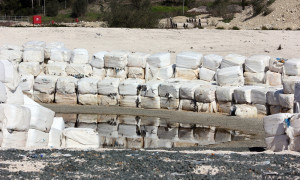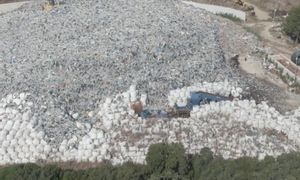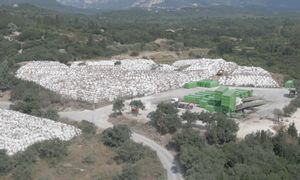Air pollutants in Temploni at low levels according to ‘Demokritos’

Temploni
21 Jul 2022
/ 18:27
CORFU. Livestock and olive products are under Demokritos ‘microscope’ due to illegal waste incineration in Ropa Valley.
The first conclusions of the measurements of air pollutants in Temploni were announced following the sampling and chemical analyses conducted by the National Centre for Scientific Research ‘Demokritos’.
As shown in the report, all the toxicants found are either at low levels or within limits. However, particular emphasis is expected to be placed on the sampling and analysis of livestock and olive products in the Temploni landfill, due to the illegal waste incineration in Ropa Valley during the sampling period.
The results announced concern the first period of analyses, while a second period of sampling and analyses will follow, which will be completed in about a year from now.
The conclusions
In particular, after the measurements, the following conclusions were found:
-Total dioxin and furan toxicity concentration values measured in Temploni during the first sampling period were at low levels, similar to those detected in remote rural areas and lower than those detected in the centre of Athens.
-The total toxicity values for “dioxin-like” PCBs and total indicator PCBs measured during this period were at low levels for an area with rural and urban activities.
-The limit concentration of PM10 was not exceeded at any sampling point.
- As far as heavy metals are concerned, the established concentration values were not exceeded in any case.
-The concentration of benzo(a)pyrene at all sampling points was below the minimum quantification limit and the proposed concentration limit value of 1 ng/m3. The concentration of benzene did not exceed the proposed concentration limit value of 5 ng/m3 in any of the samples taken at the points under inspection.
Livestock and olive products
However, particular emphasis is expected to be placed on the sampling and analysis of livestock and olive products in Temploni landfill.
This is because during the sampling period, illegal incineration of waste and other materials was taking place on a daily basis in Ropa Valley, apparently to extract metals and sell them.
“Waste incineration produces significant amounts of harmful chemicals, the most dangerous of which are dioxins, polyaromatic hydrocarbons and heavy metals. All these substances pollute the air, are deposited in the soil, plants, surface water and end up in animals, where they bioaccumulate and eventually end up in food. From previous studies by the Laboratory for Mass Spectrometry and Dioxin Analysis in similar cases, it is known that there is a serious burden on livestock and agricultural products located up to 5 km from the fire source, with the burden decreasing when the distance is increasing, depending also on the volume of waste, the extent and duration of the incineration, as well as the wind direction,” stated the report by the National Centre for Scientific Research ‘Demokritos’.
Contract
Demokritos’ research in Temploni is being carried out as part of the contract signed between the Ionian Islands Region and the research centre for the complete monitoring of the environmental situation in Temploni and the surrounding area.
This research will last for three years and includes sampling and specialised chemical analyses of air quality, groundwater, soil, livestock and olive products in the landfill and the surrounding area.
As shown in the report, all the toxicants found are either at low levels or within limits. However, particular emphasis is expected to be placed on the sampling and analysis of livestock and olive products in the Temploni landfill, due to the illegal waste incineration in Ropa Valley during the sampling period.
The results announced concern the first period of analyses, while a second period of sampling and analyses will follow, which will be completed in about a year from now.
The conclusions
In particular, after the measurements, the following conclusions were found:
-Total dioxin and furan toxicity concentration values measured in Temploni during the first sampling period were at low levels, similar to those detected in remote rural areas and lower than those detected in the centre of Athens.
-The total toxicity values for “dioxin-like” PCBs and total indicator PCBs measured during this period were at low levels for an area with rural and urban activities.
-The limit concentration of PM10 was not exceeded at any sampling point.
- As far as heavy metals are concerned, the established concentration values were not exceeded in any case.
-The concentration of benzo(a)pyrene at all sampling points was below the minimum quantification limit and the proposed concentration limit value of 1 ng/m3. The concentration of benzene did not exceed the proposed concentration limit value of 5 ng/m3 in any of the samples taken at the points under inspection.
Livestock and olive products
However, particular emphasis is expected to be placed on the sampling and analysis of livestock and olive products in Temploni landfill.
This is because during the sampling period, illegal incineration of waste and other materials was taking place on a daily basis in Ropa Valley, apparently to extract metals and sell them.
“Waste incineration produces significant amounts of harmful chemicals, the most dangerous of which are dioxins, polyaromatic hydrocarbons and heavy metals. All these substances pollute the air, are deposited in the soil, plants, surface water and end up in animals, where they bioaccumulate and eventually end up in food. From previous studies by the Laboratory for Mass Spectrometry and Dioxin Analysis in similar cases, it is known that there is a serious burden on livestock and agricultural products located up to 5 km from the fire source, with the burden decreasing when the distance is increasing, depending also on the volume of waste, the extent and duration of the incineration, as well as the wind direction,” stated the report by the National Centre for Scientific Research ‘Demokritos’.
Contract
Demokritos’ research in Temploni is being carried out as part of the contract signed between the Ionian Islands Region and the research centre for the complete monitoring of the environmental situation in Temploni and the surrounding area.
This research will last for three years and includes sampling and specialised chemical analyses of air quality, groundwater, soil, livestock and olive products in the landfill and the surrounding area.











